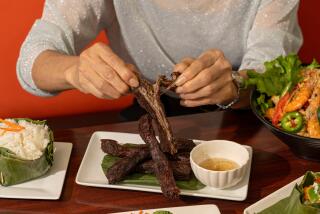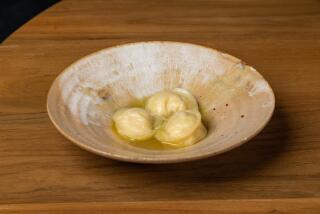Chowder: Call Me Hungry
- Share via
A pair of hungry whalers in search of a warming supper and sound sleep--Ishmael and Queequeg, narrator and harpooner in Herman Melville’s “Moby Dick”--find their way to an ominous old Nantucket inn called the Try Pots. They are greeted brusquely with the question, “Clam or cod?” and left to wait for what they fear has been promised--a single clam to be shared between the two.
“However,” Ishmael later recalls, “a warm savory steam from the kitchen served to belie the apparently cheerless prospect before us. But when that smoking chowder came in, the mystery was delightfully explained. Oh! sweet friends, hearken to me. It was made of small juicy clams, scarcely bigger than hazel nuts, mixed with pounded ship biscuits, and salted pork cut up into little flakes! The whole enriched with butter, and plentifully seasoned with pepper and salt.”
The two seamen, perhaps in unconscious anticipation of the cold, stormy times ahead, gleefully proceeded to consume not one but two bowls of hot soup each--one of clam and one of cod--and call for the same at breakfast.
While we draw the line at breakfast, my family and I can devour a bowl or two of chowder for a most satisfying supper. In fact, our chowder pot gets plenty of use throughout the year. I love chowders because they require the simplest, freshest ingredients, they are quick and easy to prepare and they cook in a matter of minutes--a bonus for any busy cook.
Even with today’s seesawing prices, fish chowder can be the most economical of dinners and one of the few ways one can successfully use less expensive frozen fin fish without sacrificing flavor or texture.
Chowder making is a remarkably simple business, requiring as few or as many ingredients as one desires. New Englanders used to refer to “building a chowder,” a process of alternating layers of salt pork, onions, thinly sliced potatoes and fish that are allowed to cook slowly.
I reinterpret the method slightly by using a standard technique to “build” all my chowders, starting with the fat, traditionally salt pork, although I use everything from bacon to olive oil. Next I add chopped onions or other aromatic vegetables such as garlic or shallots. Then comes the liquid, which can be water, milk, cream or tomatoes infused with the juices from the chosen shell or fin fish.
For many people, milky chowders are synonymous with New England. Like the Try Pots chowder, however, “most of the chowder recipes in New England cookbooks of the mid-19th Century did not include milk,” writes Linda Wolfe in “The Literary Gourmet: Menus From Masterpieces.” The original choice was simply water, the only nonalcoholic liquid available in the ship’s hold.
My first encounter with a milk-less and tomato-less chowder came at a New England inn where I worked summers. The chef’s specialty was a memorable pot of onion, celery, potatoes and chopped clams swimming in a fragrant broth. Called Rhode Island clam chowder, it forms the inspiration for the Potato-Clam Chowder recipe below.
I am of the school that likes fish cooked but not overcooked, even when I am simmering it in my chowder pot. Scrubbed shellfish or thick pieces of fish should be gently poached so that their juices will slowly infuse the chowder liquids with their fresh, briny flavor. If allowed to boil and bubble vigorously, shellfish will become tough and fish will disintegrate. Five to 15 minutes at a gentle simmer in a large, broad pot with a tight-fitting lid will render seafood juicy, sweet and perfectly cooked.
With access to a good seafood market, I look to the “catch of the day” before deciding what will go into the chowder on any particular night. Traditional recipes called for cod, scrod or haddock, but many other firm-fleshed species can be called into play, among them halibut, bass, tilefish, flounder, salmon, snapper and hake. Freshwater fish that can substitute acceptably include walleyed pike and perch.
When it comes to shellfish, clams, of course, are a favorite. Unfortunately, due to the inconsistencies in the safety of our waters, this shellfish is not as plentiful as when Ishmael and Queequeg dined at the Try Pots. I usually select the farm-raised clams. The most familiar of the farm-raised varieties are known as Manila clams and are raised in the Northwest.
The truth is that in today’s market, we must dig deep into our pockets when buying fresh clams, but thrifty landlocked cooks can substitute canned clams--which are usually chopped quahogs--and bottled clam broth.
On the other hand, mussels--especially the grit-free, farm-raised variety--are always a good and often a reasonably priced choice. Often I balance the budget by buying a combination of clams and mussels and then throwing in one jumbo shrimp per serving. My chowders vary with the types of seafood available, the season and my mood.
For accompaniments, I serve a basket of biscuits or chunks of bread and a salad of mixed greens. Unlike Ishmael and Queequeg, my family and guests don’t have the luxury of two chowders to choose from, but then again, neither do they leave even a spoonful for the next morning’s breakfast.
Drawing its flavor from the clams and celery, this no-nonsense chowder comes to the table in half an hour or less.
NEW ENGLAND POTATO-AND-CLAM CHOWDER
1 cup water
1 small onion, halved
1 bay leaf
1 leafy celery top
1/2 teaspoon salt
1 1/2 to 2 dozen cherrystone or steamer clams, scrubbed
1 pound potatoes, peeled, halved and thinly sliced
1/2 cup thinly sliced celery
2 cups milk or half and half
Freshly ground pepper
Cayenne pepper
Combine water, onion, bay leaf, celery leaf and salt in large saucepan with tight-fitting lid. Bring to boil. Add clams. Cover and cook over high heat until all clams have opened, about 5 minutes. Discard any that do not open. With slotted spoon, transfer clams to dish to cool. Strain broth. (There should be about 2 cups.)
Rinse out saucepan. Add clam broth, potatoes and celery and heat to boiling. Cover and cook over low heat until potatoes are tender, 10 to 12 minutes.
Meanwhile, shell clams and mince them with kitchen shears or knife. Pour milk into bowl and spoon little hot broth into it. Stir mixture back into saucepan. Stir in clams. Gently heat, stirring. Do not boil, or milk may curdle. Remove bay leaf. Season to taste with black and cayenne peppers. Makes 4 servings.
This most basic of all chowders is constructed following Ishmael’s description in “Moby Dick.” To make it, do not use crackers with salted tops, or the result will be unbearably saline. An easy way to shuck clams is to spread them on a baking sheet and place them in the freezer just long enough for the shells to begin opening. Then use a clam knife to separate the shells.
MRS. HUSSEY’S CHOWDER
4 to 6 dozen Manila or small littleneck clams, scrubbed, then shucked over bowl to catch clam juice
2 slices salt pork, cut into small pieces (about 1/4 cup)
1 cup unsalted cracker crumbs (such as Carr’s Water Crackers), crushed with rolling pin
4 teaspoons unsalted butter
Cayenne pepper
Strain clam juice. Measure clams and liquid and add enough water to make 4 cups. Cook salt pork over medium heat in large saucepan 3 to 5 minutes or until fat is rendered and pork is browned. Add clams and liquid. Heat, stirring, over medium heat until clams are tender, about 5 minutes.
Meanwhile, spread layer of cracker crumbs in bottom of 4 bowls. Cut butter into small pieces and divide evenly among bowls. Season chowder to taste with cayenne pepper. With slotted spoon, distribute clams evenly among bowls. Ladle boiling liquid over clams. Makes 4 servings.
Simmering the corn cobs in the broth adds flavor, but adding the kernels and salmon later results in crisp corn and tender but not overdone fish.
SALMON-CORN CHOWDER
3 ears corn
1 tablespoon unsalted butter
1/3 cup chopped shallots
2 cups unsalted chicken stock, preferably homemade
1/2 bay leaf
1 sprig fresh thyme or 1/4 teaspoon dried, plus additional fresh for garnish
1/4 cup uncooked long-grain white rice
1 teaspoon salt
2 cups half and half
12 ounces fresh salmon, skin and bones discarded, cut into 2-inch pieces
Hot pepper sauce
1/4 cup finely minced sweet red pepper
Freshly ground pepper
Cut kernels from corn (there should be about 2 1/2 cups) and reserve cobs.
Heat butter in large, heavy saucepan over medium heat. Add shallots and saute, stirring, until tender, about 3 to 5 minutes. Add chicken stock, bay leaf, thyme and corn cobs. Heat to boiling. Reduce heat. Cover and simmer over low heat 20 minutes. Remove corn cobs and discard. Stir in rice and salt. Cover and cook over low heat until rice is done, about 20 minutes.
Stir in half and half and corn kernels. Cook, uncovered, over medium heat until hot (do not boil). Reduce heat to low and simmer, stirring occasionally, 10 minutes.
Add salmon. Cover and cook 5 minutes or until fish is cooked through (do not boil). Remove bay leaf. Season to taste with salt and hot pepper sauce. Ladle chowder into bowls. Sprinkle each with sweet red pepper, fresh thyme leaves and pepper. Makes 4 servings.
The flavor of this traditional nor’easter chowder comes mostly from the savory fish stock.
CODFISH CHOWDER
2 tablespoons diced salt pork
1 medium onion, diced
1 1/2 teaspoons butter
1 teaspoon chopped fresh thyme or 1/4 teaspoon dried
2 tablespoons flour
1 pound potatoes, peeled and diced
2 cups Fish Stock
2 bay leaves
1 1/2 pounds cod fillets, cut into large chunks
1 1/2 cups skim or low-fat milk
1/4 teaspoon salt
Freshly ground pepper
Saute salt pork over low heat in large saucepan, stirring, about 3 minutes, or until fat renders and pork browns. Add onion, butter and thyme and saute, stirring, 3 to 4 minutes, or until onions are tender.
Add flour and saute, stirring, 1 minute. Add potatoes, Fish Stock and bay leaves. Simmer 15 to 20 minutes, or until potatoes are tender. Remove bay leaves. Add cod and milk. Simmer 8 to 10 minutes, or until fish is cooked through. Season to taste with salt and pepper. Makes 4 servings.
Fish Stock
5 cups water
2 1/2 pounds bones from white fish, such as cod, rinsed
1 cup dry white wine
1 medium onion, sliced
1 stalk celery, chopped
5 black peppercorns
3 cloves garlic, unpeeled, crushed
1/3 cup mushroom stems, optional
Bouquet garni of 10 sprigs parsley, 3 sprigs thyme and 1 bay leaf
Combine water, fish bones, wine, onion, celery, peppercorns, garlic, mushroom stems and bouquet garni in large stockpot. (Water should just cover bones.) Bring almost to boil. Reduce heat and simmer, uncovered, 30 minutes. Skim foam from surface. Strain stock and discard solids. Freeze leftovers. Makes about 5 cups.
More to Read
Eat your way across L.A.
Get our weekly Tasting Notes newsletter for reviews, news and more.
You may occasionally receive promotional content from the Los Angeles Times.










